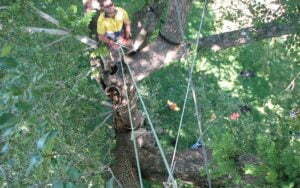Tree Pruning
Pruning can serve several purposes, correct pruning techniques can improve: tree health, structure and form. Pruning can increase trees useful life expectancy and reduce likelihood of branch/stem or whole tree failure.
The Tree Company can help maintain your trees by: aerially inspecting, formative pruning, weight reduction pruning, removing dead-wooding and safety bracing. You can rely on our ability to give sound advice and options on how best to manage your trees to maintain or improve their health, shape and structural integrity.
We prune trees to Australian Standards AS 4373 – ‘Pruning of Amenity Trees’, as well as abiding by local regulations and requirements.
Our Pruning and Shaping Services Backed by Decades of Experience
Whether your reasons for pruning are to promote strong, health trees, manage tree size, supress to reduce the likelihood of failures or purely for aesthetic purposes. Our highly trained team are here to help.
Tree pruning can be a difficult process, and carrying this out without the relevant experience, with inadequate equipment or at the wrong time of year can be detrimental to your tree’s health and longevity. Our team can accurately advise what is required to manage your trees and quote accordingly.

Maintenance Pruning
To control tree branches growing towards or overhanging structures, such as roofs, gutters, fence lines and power lines. When undertaking maintenance pruning to deliver adequate clearance of property, we also aim to maintain the health and shape of trees.
Deadwood Removal / Hazardous Branch Removals
This involves removing dead, dying and damaged branches to reduce the likelihood of branch failure. If hazardous branches are not removed, particularly those overhanging high use areas, they may pose a serious safety risk.

Weight Reduction Pruning
Generally carried out if branch’s or stems are heavy and overextended, using branch end pruning and formative pruning techniques; while retaining the natural shape and balance of the tree. We recommend this corrective measure to reduce the risk of branch, stem and/or whole-tree failure.
Formative & Structural Pruning
Formative pruning of trees will ensure your tree has the best chance to reach its full potential in terms of structure, form, canopy coverage and overall health. This includes removing or suppressing defects, such as included stems, crossing branches, heavy/overextended branches, co-dominant stems and epicormic growth, etc.

Canopy Thinning
Removing selected internal growth, often used to allow more sunlight penetration and create a more open canopy. This is especially important for trees growing on sites with restricted space or in an environment where you’d like to have more sun reaching the area under the tree for plants or lawn. Done by evenly removing duplicate and crossing branches.
Canopy Uplifting
Increasing the height of low canopy above the ground or above structures by removing or uplifting the lowest branches. This can improve clearance for vehicles, pedestrians and houses, as well as improving the overall appearance of your trees.
Canopy Reduction Pruning
Canopy reduction pruning reduces the overall size and spread of a tree’s canopy whilst retaining its natural shape. This type of pruning is useful for trees on their way to becoming too large for their environment, to reduce stresses (leverage) on branch/stem attachments, and for overall aesthetics.
See us in action






